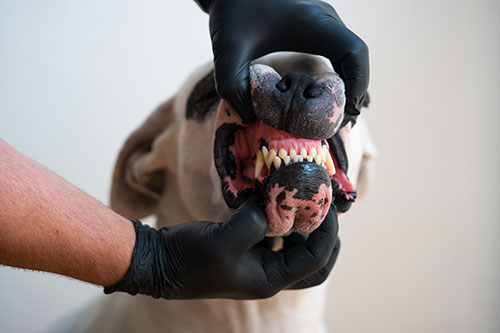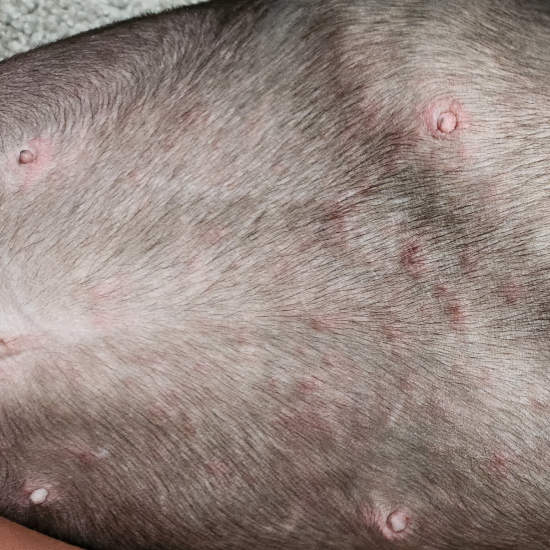
This article was updated on September 19th, 2023
When I worked as a veterinarian in a pet clinic, owners would often call me because their dogs had red, itchy bumps, and they were not sure what to do. After asking questions about the dogs’ recent activities and if there were other signs, I would often advise them to bring their dogs in for a physical exam because their dogs likely had hives.
Hives appear as raised, red bumps on the skin, and are usually part of an allergic reaction. In this article, I’ll show you examples of different ways hives can present themselves and explain which other conditions may have a similar appearance. To help you when your dog has hives, I’ll also explain what you can do at home for your pooch and when you should call your veterinarian.
What hives look like in dogs (with pictures)
Hives in dogs can be fairly mild and localized such as allergic reactions to plant toxins (poison ivy) or insect bites. They can also be severe and more widespread as you will see in flea bite allergies or reactions to medications.
1. Mild/localized reactions
Insect bites/vaccine reactions
In this picture, the dog has a few welts on her hind leg. Notice the raised bumps under the hair along the front of the knee and thigh area. In this case, the hives are few in number.

When insects such as bees or mosquitoes bite or sting your furbaby, she may have a localized allergic reaction. This type of localized hive may also occur in a vaccine reaction, but it will be located in the area of your dog’s shot.
Contact allergies
This picture below is an example of hives and an allergic reaction that your dog may have from contact with a toxic plant like stinging nettle or poison ivy. Often the lesions appear on the feet because your pooch walks through a patch of offending plants.
Notice the patches of raised, darker hair on the top of the foot. This can be a sign of inflammation and hives. Dark spots as seen in the picture can occur when your dog licks or chews the area, abrading the skin and causing a discharge:

The second picture (below) is a shot from the underside of the foot. It appears inflamed and reddened. Observe how the tissue swells in the interdigital spaces:

On the two pictures below, you can see several patches of raised and pink skin (with localized fur loss) – these have come up overnight on this dog as a result of an allergic reaction:


Food allergy/sensitivity
Dogs can also develop hives and itching from food allergies or sensitivities. The trigger food varies from one canine to another and can trigger atopic dermatitis with raised itchy bumps.
Notice the reddened gums and inflamed muzzle of this dog. The skin on the chin appears to have small, raised lumps or hives.

In the foot shot, you can see red, irritated skin with a few red bumps in the interdigital spaces. Food allergy reactions can manifest on the skin anywhere on the body.

2. Severe/generalized reactions
Flea allergy
Dogs that have allergic reactions to flea saliva can develop widespread red bumps along the stomach, back, or anywhere the fleas bite.
Notice the raised wheals and hair loss around this dog’s tail head. The hair loss may be caused by repeated scratching or chewing at the area to relieve itching.

On the stomach, there’s a broadly spread rash that includes multiple small red bumps. Some of the bumps are joined into larger welts.

Reaction to medication
Hives and facial swelling can occur with allergic reactions to some medications including antibiotics, vitamin K, and chemotherapy drugs. Severe reactions are medical emergencies that require immediate veterinary attention.

This English Bulldog has a swollen face and reddened snout due to an allergic reaction to something. Notice how the jowls are 2-3 times the normal size. When you see swelling like this, take your dog to the vet.

After receiving a vitamin K treatment, this dog broke out in hives and experienced facial swelling. Notice the bumps on top of the head and swollen eyes.
When dogs have severe facial swelling and hives, it’s time to call the vet. This can be a sign of anaphylactic shock. Monitor your pooch closely for signs of respiratory distress, pale gums, or collapse.
Signs that your dog has hives (with pictures)
Signs of hives in your dog can include visible bumps and other changes:
- Raised, red bumps on the skin or mucous membranes


- Extreme itching/scratching
- Swelling (angioedema)

- Excessive drooling if swelling is around the face/mouth
- Puffy, swollen face

Does my dog have hives, or is it something else?
Hives can be confused with certain other skin lumps and bumps such as tumors, growths, or cysts. They may also look like or appear in combination with certain skin infections. To help you differentiate hives from other conditions, look for the following characteristics:
- The lesions arise suddenly, usually due to an allergic reaction.
- Hives are red and itchy.
- Hives come in clusters; they’re rarely isolated unless it’s from a single insect bite or sting.
- Hive reactions tend to be localized.
- Hives usually retain hair/fur.
Steps you can take at home to help your dog when he has hives
The first time you notice hives on your dog, contact your veterinarian and schedule a check-up. If your pooch has occasional hives, and the doctor is aware of the condition, you may be able to treat it at home. Be sure to follow the vet’s instructions.
While you’re waiting for the appointment, you can follow these steps to try to ease your pup’s discomfort.
- Remove the allergic trigger(if possible),
- Apply cold compresses to the area or use a cool bath to reduce inflammation/itching and soothe the skin
- Give your dog over-the-counter antihistamines if directed by your vet
Are there products that can be tried safely at home to see if they can help?
Usually, hives tend to resolve on their own in about 1-3 days after you remove the trigger. However, you can try some things at home to ease your dog’s itching and inflammation.
- Wash your dog with a dog-safe oatmeal shampoo like Earthbath Oatmeal and Aloe Dog Shampoo to soothe the skin. This product includes oatmeal, aloe, and vitamins to help reduce inflammation, soothe itchiness, and support skin health.
- Apply coconut oil such as Raw Paws Organic Coconut Oil. This product can be applied topically to the skin and paws to help reduce inflammation and soothe irritated skin.
- Make a 50/50 mixture of apple cider vinegar and water or use Burt’s Bees Natural Hot Spot Spray for Dogs to spray on itchy skin.
When should you call your veterinarian?
Because hives are an allergic reaction, you should contact your veterinarian and follow his instructions whenever your dog develops itchy, raised wheals. He may advise you to give your dog some Benadryl and observe him at home. If home treatment doesn’t help and your dog’s hives continue for more than 1-2 days, take your pooch to the vet.
Repeated or intermittent outbreaks have a tendency to grow more severe over time, so watch your dog closely. Take your furbaby to the emergency clinic or your vet immediately if you observe:
- Facial swelling
- Breathing difficulties like panting or wheezing
- Raised, red bumps persist for more than several hours or reoccur
- Hives that don’t respond to home remedies/treatment
- Vomiting/diarrhea
- Weakness/lethargy
- Pale gums
Disclaimer: This website's content is not a substitute for veterinary care. Always consult with your veterinarian for healthcare decisions. Read More.


Be the first to comment